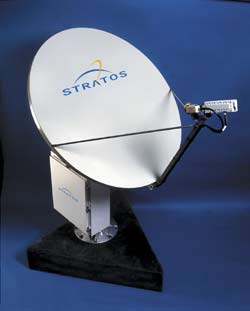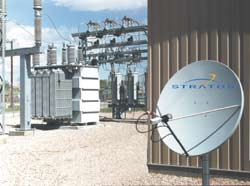
It’s been said that communication is an enabling technology… I believe that communication is “the” enabling technology. Simply put, the ability to communicate has enabled the viability and growth of the human race. I can imagine the inventor of the wheel conveying the usefulness of the invention to another potential user. While the wheel is arguably the most significant invention of the human race, the transfer of knowledge was made possible through the ability to communicate from one individual to another.
Satellite communication has been with us since the very beginning of the space age. Once the sole property of governments, satellite communication is now available to anyone who has a need to communicate over long distances. We’ve all become accustomed to satellite delivered information. Whether viewing the Super Bowl or enjoying a conversation with a child or parent in a distant location, satellites enable us to communicate over very long distances easily and in most cases transparently.
In keeping with the “better, faster, cheaper” spirit of the electronics age, access to satellite communication has come down from the lofty heights of expensive, government owned, and complex systems. Satellite communication is now available to anyone with the need to communicate. In fact, installation and operation of a satellite communications system can be more cost effective than traditional terrestrial communication systems, often with the added benefits of much higher reliability than traditional terrestrial solutions.
Through high volume manufacturing, large customer bases and simplicity of installation and operation, the cost of satellite communication systems have dropped dramatically in recent years. Equipment that once cost upward of $15K is now approaching one-third that cost. Bandwidth is nearly unlimited, and new devices are arriving in the market at a furious clip, fanning the fire of application development.
Utility companies have traditionally been challenged with communication to both equipment and personnel located in very remote, often very rugged locations. Satellite communication is ideally suited to these applications. Because the satellite (repeater) is located high above the user, access to communication infrastructure is generally not hampered by obstacles such as mountains or long distances.
The third clear advantage of satellite communication is reliability. The satellite is physically located outside the atmospheric envelope and is immune from the effects of weather, lightning, and malicious damage. On the terrestrial side, the equipment is generally placed low to the ground and is small and unobtrusive. Unlike a large tower with antennas, the ground equipment is not obtrusive and can actually be hidden behind the fence inside a substation.
So, now that we’ve discussed the advantages of satellite communication. What technologies are available and how are they used? What equipment is required and how is that equipment installed?
Satellite communication technologies are available in two general flavors: GEO (Geostationary Earth Orbit) and LEO (Low Earth Orbit).
GEO satellites operate in geosynchronous orbit, where the period of revolution of the satellite is equal to the period of rotation of the Earth. This simply means that the satellite is in the same spot relative to any given location on the Earth. From an application point of view, a GEO satellite is in a known location and applications can be near real time. GEO satellite communication makes SCADA, load management and other applications that require real time data and access possible.
LEO technologies require a constellation of satellites that are typically launched in a polar orbit, allowing one pass over a given location every 90 minutes. While not typically suitable for real time applications, LEO technology is suited for “store & forward” applications.
There are three basic parts to a satellite communication system. The satellite, ground equipment and a hub or Earth Station. In simple terms, the satellite is simply a repeater. The satellite receives the information from the ground station and reflects this information to the hub. The hub (or Earth Station) is the data processing portion of the system. The hub receives the information from the satellite and then redirects the information to the appropriate owner. Of course, since the satellite is simply a repeater, this data flow may be fully bi-directional depending on the abilities of the ground equipment.
In utility applications such as SCADA and Load Management, bi-directional ground equipment is required. These devices are generally in a class of transceivers known as Very Small Aperture Terminals (VSATs). The VSAT consists of two basic components: the IDU (Indoor Unit) and the ODU (Outdoor Unit). The ODU is comprised of two components: a receiver and a transmitter. The IDU is the brains of the system and contains the up-converter, down-converter, as well as field interfaces such as RS-232 and Ethernet.

Field devices such as RTUs and IEDs are connected to the interfaces on the IDU. Information passing through the IDU is converted to the appropriate frequencies and beamed to the satellite. The satellite simply bounces the information to the hub and the hub forwards the information to the owner. The exact same data flow also happens in reverse, where the information is conveyed to the hub, the hub converts the information to the appropriate frequencies and transmits the information to the IDU via the satellite. The IDU decodes the information and passes the data to the appropriate field device. And, all this happens in fractions of a second and is transparent to the end user!
We’ve discussed VSATs in basic detail. VSATs are an excellent tool for field telemetry of SCADA information coming from several field devices. VSATs have the ability to handle large amounts of data. However there are many, many “low data” applications coming from single points. An excellent tool for use in these applications is a relatively new device simply known as a Satellite Modem. These devices are designed specifically for single point applications such as real-time metering information, and recloser control. Satellite Modems are very small and can be mounted virtually anywhere the southern sky can be seen.
Satellite telemetry is inexpensive, very reliable, and usable virtually anywhere. How can you benefit from adding satellite communications to your tool set?
About the Author
Tony Thomas currently serves Stratos VSAT, Inc. as a Sales Executive and is responsible for sales of Stratos VSAT products for the utility sector globally. Mr. Thomas earned a BSEE and has over 20 years experience in the fields of Energy and Utility Automation







